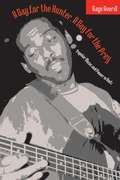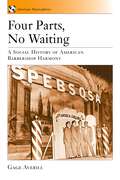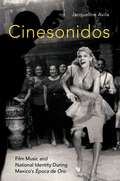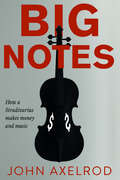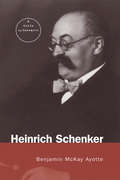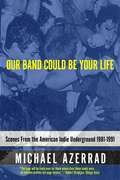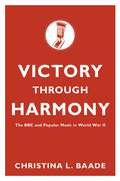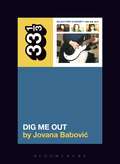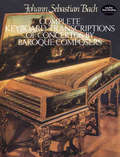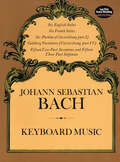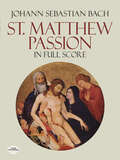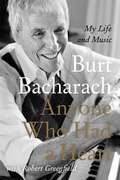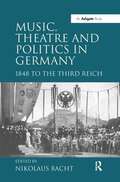- Table View
- List View
A Day for the Hunter, a Day for the Prey: Popular Music and Power in Haiti (Chicago Studies in Ethnomusicology #1997)
by Gage AverillThe history of Haiti throughout the twentieth century has been marked by oppression at the hands of colonial and dictatorial overlords. But set against this "day for the hunter" has been a "day for the prey," a history of resistance, and sometimes of triumph. With keen cultural and historical awareness, Gage Averill shows that Haiti's vibrant and expressive music has been one of the most highly charged instruments in this struggle—one in which power, politics, and resistance are inextricably fused. Averill explores such diverse genres as Haitian jazz, troubadour traditions, Vodou-jazz, konpa, mini-djaz, new generation, and roots music. He examines the complex interaction of music with power in contexts such as honorific rituals, sponsored street celebrations, Carnival, and social movements that span the political spectrum. With firsthand accounts by musicians, photos, song texts, and ethnographic descriptions, this book explores the profound manifestations of power and song in the day-to-day efforts of ordinary Haitians to rise above political repression.
A Day for the Hunter, a Day for the Prey: Popular Music and Power in Haiti (Chicago Studies in Ethnomusicology #1997)
by Gage AverillThe history of Haiti throughout the twentieth century has been marked by oppression at the hands of colonial and dictatorial overlords. But set against this "day for the hunter" has been a "day for the prey," a history of resistance, and sometimes of triumph. With keen cultural and historical awareness, Gage Averill shows that Haiti's vibrant and expressive music has been one of the most highly charged instruments in this struggle—one in which power, politics, and resistance are inextricably fused. Averill explores such diverse genres as Haitian jazz, troubadour traditions, Vodou-jazz, konpa, mini-djaz, new generation, and roots music. He examines the complex interaction of music with power in contexts such as honorific rituals, sponsored street celebrations, Carnival, and social movements that span the political spectrum. With firsthand accounts by musicians, photos, song texts, and ethnographic descriptions, this book explores the profound manifestations of power and song in the day-to-day efforts of ordinary Haitians to rise above political repression.
Four Parts, No Waiting: A Social History of American Barbershop Quartet (American Musicspheres #1)
by Gage AverillFour Parts, No Waiting investigates the role that vernacular, barbershop-style close harmony has played in American musical history, in American life, and in the American imagination. Starting with a discussion of the first craze for Austrian four-part close harmony in the 1830s, Averill traces the popularity of this musical form in minstrel shows, black recreational singing, vaudeville, early recordings, and in the barbershop revival of the 1930s. In his exploration of barbershop, Averill uncovers a rich musical tradition--a hybrid of black and white cultural forms, practiced by amateurs, and part of a mythologized vision of small-town American life. Barbershop harmony played a central -- and overlooked -- role in the panorama of American music. Averill demonstrates that the barbershop revival was part of a depression-era neo-Victorian revival, spurred on by insecurities of economic and social change. Contemporary barbershop singing turns this nostalgic vision into lived experience. Arguing that the "old songs" function as repositories of idealized social memory, Averill reveals ideologies of gender, race, and class. This engagingly-written, often funny book critiques the nostalgic myths (especially racial myths) that have surrounded the barbershop revival, but also celebrates the civic-minded, participatory spirit of barbershop harmony. The contents of the CD have been replaced by a companion website with helpful links, resources, and audio examples.
Cinesonidos: Film Music and National Identity During Mexico's Época de Oro (Oxford Music/Media Series)
by Jacqueline AvilaDuring Mexico's silent (1896-1930) and early sound (1931-52) periods, cinema saw the development of five significant genres: the prostitute melodrama (including the cabaretera subgenre), the indigenista film (on indigenous themes or topics), the cine de añoranza porfiriana (films of Porfirian nostalgia), the Revolution film, and the comedia ranchera (ranch comedy). In this book, author Jacqueline Avila looks at examples from all genres, exploring the ways that the popular, regional, and orchestral music in these films contributed to the creation of tropes and archetypes now central to Mexican cultural nationalism. Integrating primary source material--including newspaper articles, advertisements, films--with film music studies, sound studies, and Mexican film and cultural history, Avila examines how these tropes and archetypes mirrored changing perceptions of mexicanidad manufactured by the State and popular and transnational culture. As she shows, several social and political agencies were heavily invested in creating a unified national identity in an attempt to merge the previously fragmented populace as a result of the Revolution. The commercial medium of film became an important tool to acquaint a diverse urban audience with the nuances of Mexican national identity, and music played an essential and persuasive role in the process. In this heterogeneous environment, cinema and its music continuously reshaped the contested, fluctuating space of Mexican identity, functioning both as a sign and symptom of social and political change.
CINESONIDOS OMMS C: Film Music and National Identity During Mexico's Época de Oro (Oxford Music/Media Series)
by Jacqueline AvilaDuring Mexico's silent (1896-1930) and early sound (1931-52) periods, cinema saw the development of five significant genres: the prostitute melodrama (including the cabaretera subgenre), the indigenista film (on indigenous themes or topics), the cine de añoranza porfiriana (films of Porfirian nostalgia), the Revolution film, and the comedia ranchera (ranch comedy). In this book, author Jacqueline Avila looks at examples from all genres, exploring the ways that the popular, regional, and orchestral music in these films contributed to the creation of tropes and archetypes now central to Mexican cultural nationalism. Integrating primary source material--including newspaper articles, advertisements, films--with film music studies, sound studies, and Mexican film and cultural history, Avila examines how these tropes and archetypes mirrored changing perceptions of mexicanidad manufactured by the State and popular and transnational culture. As she shows, several social and political agencies were heavily invested in creating a unified national identity in an attempt to merge the previously fragmented populace as a result of the Revolution. The commercial medium of film became an important tool to acquaint a diverse urban audience with the nuances of Mexican national identity, and music played an essential and persuasive role in the process. In this heterogeneous environment, cinema and its music continuously reshaped the contested, fluctuating space of Mexican identity, functioning both as a sign and symptom of social and political change.
Big Notes: How a Stradivarius makes money and music
by John AxelrodThe business of beating death by becoming a modern day Medici is booming. In today's economy, where investments in stocks, bonds, commodities, real estate and hedge funds have either been severely battered from the Coronavirus crash or from the rollercoaster volatility, investors are increasingly seeking non-correlated alternative investments. How? By investing in a rare instrument and becoming a patron. It is not only a good return on investment. What better way to get rich and write yourself into history books than to be the owner and donor of a Stradivarius violin to a world class soloist or a museum? Tax deductions are indeed a benefit, but immortality is a better blessing. By reading this book, you can learn from the experts in the field who understand that investing in immortality is the best way to have a meaningful and mortal life.
Heinrich Schenker: A Research and Information Guide
by Benjamin AyotteThis book consists of over 1,500 citations to both primary sources and the burgeoning secondary literature of Heinrich Schenker, annotated and subdivided by category. The citations are supplemented with indices cross-referencing entries according to individual works and analytical topic.
Heinrich Schenker: A Research and Information Guide
by Benjamin AyotteThis book consists of over 1,500 citations to both primary sources and the burgeoning secondary literature of Heinrich Schenker, annotated and subdivided by category. The citations are supplemented with indices cross-referencing entries according to individual works and analytical topic.
Musical Resilience: Performing Patronage in the Indian Thar Desert (Music / Culture)
by Shalini R. AyyagariIn Musical Resilience, Shalini Ayyagari shows how professional low-caste musicians from the Thar Desert borderland of Rajasthan, India have skillfully reinvented their cultural and economic value in postcolonial India. Before India's independence in 1947, the Manganiyar community of hereditary musicians were tied to traditional patrons over centuries and through hereditary ties. In postcolonial India, traditional patronage relations faded due to new political conditions, technological shifts, and cultural change. Ayyagari uses resilience, one of the most poignant keywords of our times, to understand how Manganiyar musicians sustain and enliven their cultural significance after the fading of traditional patronage.
Our Band Could Be Your Life: Scenes from the American Indie Underground, 1981-1991
by Michael AzerradThe definitive chronicle of underground music in the 1980s tells the stories of Black Flag, Sonic Youth, The Replacements, and other seminal bands whose DIY revolution changed American music forever. Our Band Could Be Your Life is the never-before-told story of the musical revolution that happened right under the nose of the Reagan Eighties -- when a small but sprawling network of bands, labels, fanzines, radio stations, and other subversives re-energized American rock with punk's do-it-yourself credo and created music that was deeply personal, often brilliant, always challenging, and immensely influential. This sweeping chronicle of music, politics, drugs, fear, loathing, and faith is an indie rock classic in its own right. The bands profiled include:Sonic YouthBlack FlagThe ReplacementsMinutemenHusker DuMinor ThreatMission of BurmaButthole SurfersBig Black FugaziMudhoneyBeat HappeningDinosaur Jr.
Victory through Harmony: The BBC and Popular Music in World War II
by Christina L. BaadeTo serve the British nation in World War II, the BBC charged itself with mobilizing popular music in support of Britain's war effort. Radio music, British broadcasters and administrators argued, could maintain civilian and military morale, increase industrial production, and even promote a sense of Anglo-American cooperation. Because of their widespread popularity, dance music and popular song were seen as ideal for these tasks; along with jazz, with its American associations and small but youthful audience, these genres suddenly gained new legitimacy at the traditionally more conservative BBC. In Victory through Harmony, author Christina Baade both tells the fascinating story of the BBC's musical participation in wartime events and explores how popular music and jazz broadcasting helped redefine notions of war, gender, race, class, and nationality in wartime Britain. Baade looks in particular at the BBC's pioneering Listener Research Department, which tracked the tastes of select demographic groups including servicemen stationed overseas and young female factory workers in order to further the goal of entertaining, cheering, and even calming the public during wartime. The book also tells how the wartime BBC programmed popular music to an unprecedented degree with the goal of building national unity and morale, promoting new roles for women, virile representations of masculinity, Anglo-American friendship, and pride in a common British culture. In the process, though, the BBC came into uneasy contact with threats of Americanization, sentimentality, and the creativity of non-white "others," which prompted it to regulate and even censor popular music and performers. Rather than provide the soundtrack for a unified "People's War," Baade argues, the BBC's broadcasting efforts exposed the divergent ideologies, tastes, and perspectives of the nation. This illuminating book will interest all readers in popular music, jazz, and radio, as well as British cultural history and gender studies.
The Collected Essays of Milton Babbitt
by Milton Babbitt Stephen Peles Stephen Dembski Andrew Mead Joseph N. StrausLike his compositions, Milton Babbitt's writings about music have exerted an extraordinary influence on postwar music and thinking about music. In essays and public addresses spanning fifty years, Babbitt has grappled profoundly with central questions in the composition and apprehension of music. These writings range from personal memoirs and critical reviews to closely reasoned metatheoretical speculations and technical exegesis. In the history of music theory, there has been only a small handful of figures who have produced work of comparable stature. Taken as a whole, Babbitt's writings are not only an invaluable testimony to his thinking--a priceless primary source for the intellectual and cultural history of the second half of the twentieth century--but also a remarkable achievement in their own right. Prior to this collection, Babbitt's writings were scattered through a wide variety of journals, books, and magazines--many hard to find and some unavailable--and often contained typographical errors and editorial corruptions of various kinds. This volume of almost fifty pieces gathers, corrects, and annotates virtually everything of significance that Babbitt has written. The result is complete, authoritative, and fully accessible--the definitive source of Babbitt's influential ideas.
The Collected Essays of Milton Babbitt
by Milton Babbitt Stephen Peles Stephen Dembski Andrew Mead Joseph N. StrausLike his compositions, Milton Babbitt's writings about music have exerted an extraordinary influence on postwar music and thinking about music. In essays and public addresses spanning fifty years, Babbitt has grappled profoundly with central questions in the composition and apprehension of music. These writings range from personal memoirs and critical reviews to closely reasoned metatheoretical speculations and technical exegesis. In the history of music theory, there has been only a small handful of figures who have produced work of comparable stature. Taken as a whole, Babbitt's writings are not only an invaluable testimony to his thinking--a priceless primary source for the intellectual and cultural history of the second half of the twentieth century--but also a remarkable achievement in their own right. Prior to this collection, Babbitt's writings were scattered through a wide variety of journals, books, and magazines--many hard to find and some unavailable--and often contained typographical errors and editorial corruptions of various kinds. This volume of almost fifty pieces gathers, corrects, and annotates virtually everything of significance that Babbitt has written. The result is complete, authoritative, and fully accessible--the definitive source of Babbitt's influential ideas.
The Hallelujah Effect: Philosophical Reflections on Music, Performance Practice, and Technology (Ashgate Popular and Folk Music Series)
by Babette BabichThis book studies the working efficacy of Leonard Cohen's song Hallelujah in the context of today's network culture. Especially as recorded on YouTube, k.d. lang's interpretation(s) of Cohen's Hallelujah, embody acoustically and visually/viscerally, what Nietzsche named the 'spirit of music'. Today, the working of music is magnified and transformed by recording dynamics and mediated via Facebook exchanges, blog postings and video sites. Given the sexual/religious core of Cohen's Hallelujah, this study poses a phenomenological reading of the objectification of both men and women, raising the question of desire, including gender issues and both homosexual and heterosexual desire. A review of critical thinking about musical performance as 'currency' and consumed commodity takes up Adorno's reading of Benjamin's analysis of the work of art in the age of mechanical reproduction as applied to music/radio/sound and the persistent role of 'recording consciousness'. Ultimately, the question of what Nietzsche called the becoming-human-of-dissonance is explored in terms of both ancient tragedy and Beethoven's striking deployment of dissonance as Nietzsche analyses both as playing with suffering, discontent, and pain itself, a playing for the sake not of language or sense but musically, as joy.
The Hallelujah Effect: Philosophical Reflections on Music, Performance Practice, and Technology (Ashgate Popular and Folk Music Series)
by Babette BabichThis book studies the working efficacy of Leonard Cohen's song Hallelujah in the context of today's network culture. Especially as recorded on YouTube, k.d. lang's interpretation(s) of Cohen's Hallelujah, embody acoustically and visually/viscerally, what Nietzsche named the 'spirit of music'. Today, the working of music is magnified and transformed by recording dynamics and mediated via Facebook exchanges, blog postings and video sites. Given the sexual/religious core of Cohen's Hallelujah, this study poses a phenomenological reading of the objectification of both men and women, raising the question of desire, including gender issues and both homosexual and heterosexual desire. A review of critical thinking about musical performance as 'currency' and consumed commodity takes up Adorno's reading of Benjamin's analysis of the work of art in the age of mechanical reproduction as applied to music/radio/sound and the persistent role of 'recording consciousness'. Ultimately, the question of what Nietzsche called the becoming-human-of-dissonance is explored in terms of both ancient tragedy and Beethoven's striking deployment of dissonance as Nietzsche analyses both as playing with suffering, discontent, and pain itself, a playing for the sake not of language or sense but musically, as joy.
Handel’s Messiah: The Creative Process
by Amanda BabingtonThe soundtrack of the Christmas season for many music lovers, Messiah is performed annually by choral societies across the world. And so, perhaps unsurprisingly, many aspects of it have been explored by scholars over the years. The work is the subject of several listeners’ guides and there are a number of books and articles of various lengths that describe the biographical circumstances of the work’s formation and details of its many performances, many including lists of singers for each performance (an area that has itself spawned a whole field of research).There has been no extensive study of the creative process of Messiah, however, since 1969. This book seeks to redress this imbalance by providing a thorough investigation of the work’s creative process. Beginning with the creative process of the libretto, it examines the earliest sketches, Handel’s use of pre-existent material, alterations made to the autograph score, and the latest versions of movements. Each stage of composition is examined via primary source material, with particular reference to the autograph score and conducting score. Each chapter is formed as a case study and contains related discussion points for use in teaching or study settings.
Handel’s Messiah: The Creative Process
by Amanda BabingtonThe soundtrack of the Christmas season for many music lovers, Messiah is performed annually by choral societies across the world. And so, perhaps unsurprisingly, many aspects of it have been explored by scholars over the years. The work is the subject of several listeners’ guides and there are a number of books and articles of various lengths that describe the biographical circumstances of the work’s formation and details of its many performances, many including lists of singers for each performance (an area that has itself spawned a whole field of research).There has been no extensive study of the creative process of Messiah, however, since 1969. This book seeks to redress this imbalance by providing a thorough investigation of the work’s creative process. Beginning with the creative process of the libretto, it examines the earliest sketches, Handel’s use of pre-existent material, alterations made to the autograph score, and the latest versions of movements. Each stage of composition is examined via primary source material, with particular reference to the autograph score and conducting score. Each chapter is formed as a case study and contains related discussion points for use in teaching or study settings.
Sleater-Kinney's Dig Me Out (33 1/3)
by Jovana BabovicSleater-Kinney's 1997 album Dig Me Out is built on Corin Tucker and Carrie Brownstein's competing guitars, Janet Weiss's muscular rhythms, and layered vocals that teeter between an urgent, banshee-like vibrato and a lower accompaniment. Dig Me Out was the band's third studio album, but the first one written and recoded with Weiss. It inaugurated Sleater-Kinney into a lineup that would span its two-decade career.This 33 1/3 follows the narrative of Dig Me Out from its inception in Olympia to its recording in Seattle and its reception across the United States. It's anchored in a short period of time – roughly from mid-1996 to mid-1998 – but it encompasses a series of battles over meaning that continued to preoccupy Sleater-Kinney in the coming decades. The band wrestled with the media about how they would be presented to the public, it contended with technicians about how their sound would be heard in clubs, and they struggled with pervasive social hierarchies about how their work would be understood in popular culture. The only instance where the band didn't have to put up much of a fight was when it came to their fans. The acclaim Sleater-Kinney received from their listeners in the late 1990s, and continue to receive today, speaks to a need for icons who challenged normative notions of culture and gender. This story of Dig Me Out chronicles how Sleater-Kinney won the fight to define themselves on their own terms – as women and as musicians – and, in the process, how they redefined the parameters of rock.
Sleater-Kinney's Dig Me Out (33 1/3)
by Jovana BabovicSleater-Kinney's 1997 album Dig Me Out is built on Corin Tucker and Carrie Brownstein's competing guitars, Janet Weiss's muscular rhythms, and layered vocals that teeter between an urgent, banshee-like vibrato and a lower accompaniment. Dig Me Out was the band's third studio album, but the first one written and recoded with Weiss. It inaugurated Sleater-Kinney into a lineup that would span its two-decade career.This 33 1/3 follows the narrative of Dig Me Out from its inception in Olympia to its recording in Seattle and its reception across the United States. It's anchored in a short period of time – roughly from mid-1996 to mid-1998 – but it encompasses a series of battles over meaning that continued to preoccupy Sleater-Kinney in the coming decades. The band wrestled with the media about how they would be presented to the public, it contended with technicians about how their sound would be heard in clubs, and they struggled with pervasive social hierarchies about how their work would be understood in popular culture. The only instance where the band didn't have to put up much of a fight was when it came to their fans. The acclaim Sleater-Kinney received from their listeners in the late 1990s, and continue to receive today, speaks to a need for icons who challenged normative notions of culture and gender. This story of Dig Me Out chronicles how Sleater-Kinney won the fight to define themselves on their own terms – as women and as musicians – and, in the process, how they redefined the parameters of rock.
Brandenburg Concerto no 5 Third Movement, three part arrangement (PDF)
by J. S. Bach SazThis is a musical score in Modified Stave Notation. The original file is available as .mscz format and the braille music version as .brf from mas@rnib.org.uk
Complete Keyboard Transcriptions of Concertos by Baroque Composers (Dover Music For Piano Ser.)
by Johann Sebastian BachEarly in his career, Bach began to transcribe for the keyboard a number of concertos for violin, oboe, and other instruments by such baroque masters as Vivaldi and Telemann. His purpose: to study and explore the works of other composers as well as to supply good clavier music for his own performances.This collection of sixteen of these celebrated transcriptions is reprinted from the definitive Bach-Gesellschaft edition prepared by Ernst Naumann and presented in a study format designed to give amateur and professional pianists and harpsichordists a lifetime of pleasurable study and use.Six of these glorious keyboard works are known to be transcriptions of Vivaldi violin concertos. Three are based on concertos written by Duke Johann Ernst of Saxe-Weimar, the son of Bach's employer at Weimar. One is based on a violin concerto by Telemann, another on an oboe concerto by Alessandro Marcello, and another on a concerto by Benedetto Marcello. The sources of the remaining works are unknown.Vivaldi, whose music Bach probably first heard in 1712, was to provide a strong influence on the young composer. Bach would eventually assimilate the Italian's style and use it with his own contrapuntal heritage and the Northern idiom in creating what we recognize today as the typical Bach style. These transcriptions, which represent his introduction to the new idiom, richly display a dynamic virtuosity that makes their performance an exhilarating experience.
Keyboard Music
by Johann Sebastian BachThe renowned Bach-Gesellschaft, founded in 1850 to collect, edit, and publish all the known works of J. S. Bach, devoted fifty years to its monumental task. It succeeded so well in tracking down Bach's heritage, establishing authenticity, and transcribing accurate texts that it still remains the primary source for Bach's music., Unfortunately, it has always been a fantastically expensive publication, accessible only in the largest libraries.This volume reprints in full, directly from the Bach-Gesellschaft volumes, important keyboard music. It contains the full texts of the Six English Suites, the Six French Suites, Six Partitas from the Clavierübung, the Goldberg Variations, and the Two- and Three-Part Inventions and Sinfonias,The music has been reproduced in large, clear type, directly from the original editions, for maximum clarity. Designed as a playing edition, it will be a necessary book to every performer on the harpsichord or piano, every music student and musicologist, as well as to serious music listeners.
St. Matthew Passion: In Full Score
by Johann Sebastian BachOne of the most performed and recorded of Bach's major works, the St. Matthew Passion has been a focal point of concert seasons and festivals around the world for over 150 years. First performed in the late 1720s, it is a drama of epic grandeur, long considered the noblest, most inspired musical treatment of the story of the crucifixion of Christ. Bach set the text, based on two chapters from the Gospel of St. Matthew, using a large ensemble of two choruses, soloists, and two orchestras. The full score is reprinted here from the fine edition prepared by the Bach-Gesellschaft.Although the St. Matthew Passion is often held to be the apotheosis of Lutheran church music, this magnificent oratorio reaches out to its audience in the language, form, and spirit of opera. Richly dramatic and theatrical, following the general form of Baroque opera, it unfolds its deeply moving story in recitatives, ariosos, arias, chorales, and mighty choral movements. This finely produced score offers music lovers the opportunity -- at a price far lower than comparable editions -- to follow performances score in hand, and to gain a more intimate knowledge of the rich musical textures of this great masterwork.
Anyone Who Had a Heart: My Life and Music
by Burt BacharachBurt Bacharach is one of the most celebrated and legendary song-writers of the twentieth century. Throughout his sixty year career he has worked with artists from Dionne Warwick to Dr Dre, Marlene Dietrich to Elvis Costello.Anyone Who Had a Heart is the story of one of the greatest song writers of all time. It traces for the first time in his own words, the life and times of the man who created the music that has become the sound track for the lives of his millions of devoted fans all over the world.Bacharach's songs include: 'Magic Moments' - Perry Como, ' Baby It's You' - The Shirelles / The Beatles, 'Please Stay' - The Drifters / Marc Almond, 'Wishin' and Hopin'' - Dionne Warwick / Dusty Springfield / Ani DiFranco, 'Walk On By' - Dionne Warwick / The Stranglers, 'I Just Don't Know What to Do with Myself' - Dusty Springfield / The White Stripes, '(There's) Always Something There to Remind Me' - Sandie Shaw, 'A Message to Martha' - Adam Faith, 'What's New Pussycat?' - Tom Jones, 'Trains and Boats and Planes' - Billy J. Kramer & the Dakotas, 'Alfie' - Cilla Black / Cher / Rumer, 'I Say a Little Prayer' - Dionne Warwick / Aretha Franklin, 'Do You Know the Way to San Jose?' - Dionne Warwick, 'Raindrops Keep Fallin' on My Head' - B.J. Thomas / Sacha Distel / Johnny Mathis, 'I'll Never Fall in Love Again' - Bobby Gentry, 'Arthur's Theme (Best That You Can Do)' - Burt Bacharach / Barry Manilow / Shirley Bassey.
Music, Theatre And Politics In Germany: 1848 To The Third Reich
by Nikolaus BachtMusic, theatre and politics have maintained a long-standing, if varying and problematic, relationship. In the Ancient World, the relationship used to be a harmonious one, scholars have us believe, glorifying the moment at the beginning of Western history when a political community, or polis, affirmed itself in a practice that purportedly achieved the perfect integration of music and theatre. To revive this original harmony was, of course, one of the main impulses that engendered the genre of opera. However, while it is widely recognized that the political represented a prius in the Ancient triangle of music, theatre and politics, there has been little attention to the status of the political in the triangle's modern variety. Nonetheless, the relationship between the three continues to be strong. In many contexts, the political still takes priority, encouraging or curbing artistic creativity. The contributions in this volume bridge the conventional chronological division between 'late Romantic' and 'modern' music to thematize a wide array of issues in the context of Germany. The contributors focus on a national tradition and period in which the friction between music, theatre and politics grew particularly intense. Major themes include: reception history; the entwining of aesthetic and political intentions on the part of composers, critics and historians; and the construction and/or critique of collective political identities in and through music theatre.
